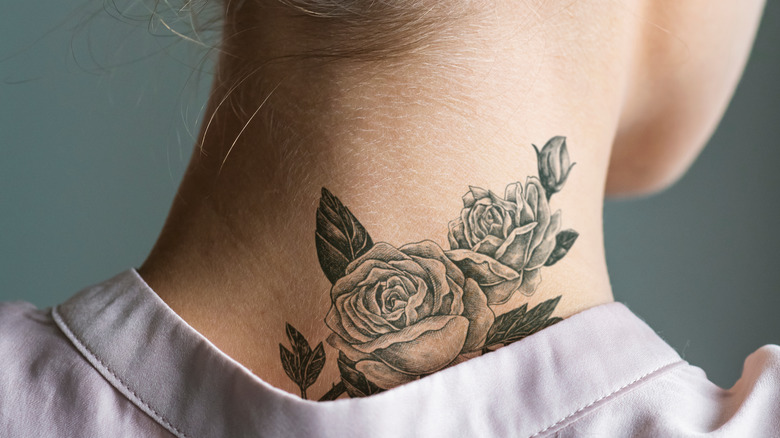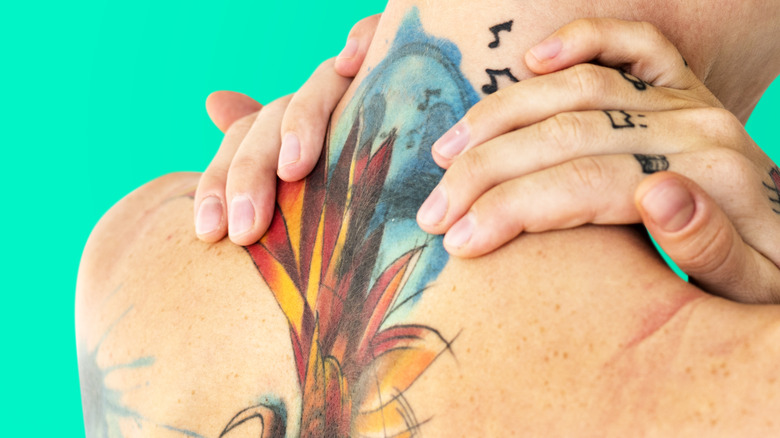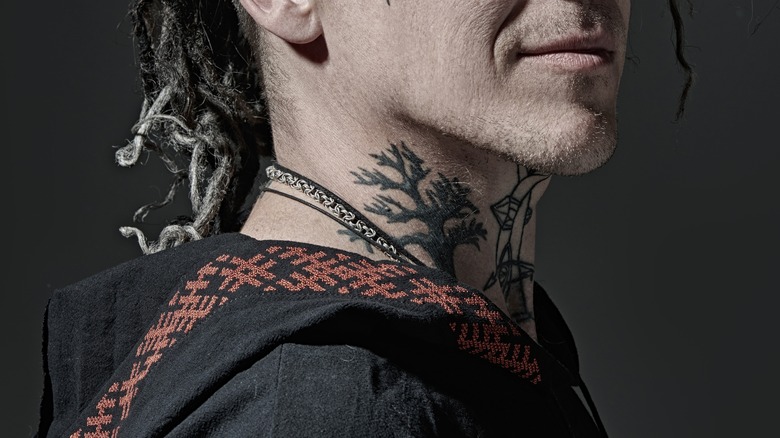What To Consider Before You Get A Neck Tattoo
The motivations for getting tattooed reflect the twists and turns in one's life story: To mark a milestone, pay tribute to a memory, or just to showcase one's individuality. Coming up with tattoo designs requires a lot of brainstorming. However, thinking about where to place the ink is no less challenging. Although you can get inked anywhere you like, some areas of the body aren't the most ideal places for the longevity of your tattoos. For instance, any tattoo that's often exposed to the sun is at risk of fading.
It may be a good idea to get inked in an area of your body that's usually covered up with clothes "if you want your ink to stay looking fresh for years to come," Florida-based tattoo artist Leo Palomino tells Bustle. Following this logic, the more optimal places for a fine ink tattoo are the inner arms, ribs, or upper legs. But what if we buck the trend and get a tattoo on the neck?
When it comes to tattoo visibility, the neck comes second only to the face. As fascinating as this concept is, it is not without risks. A number of issues must be addressed, including the procedure's safety as well as potential unfavorable reactions. If a neck tattoo is on your bucket list, here's what you should know before and after having one.
You need a thick skin
Before getting a neck tattoo, make sure you have a thick skin. The tattoo might be an art form, but it's still considered a taboo in many parts of the world, especially in a corporate environment. Coming across as heavily tattooed might project an image of unprofessionalism, especially if your tattoo conveys an offensive message unfit for a professional setting. Neck tattoos are especially hard to hide, which can make or break your employment opportunity. Therefore, consider the context of your tattoo and the nature of your job before getting one. If you're all geared up to face discrimination for your self-expression, then go ahead.
Another drawback is that neck tattoos tend to hurt more than other parts of the body. That's because the front of the neck has very thin skin and little muscle, whereas the bones, cartilage, and nerves near the skin surface abound. The level of pain for neck tattooing spans from "extremely high to intolerable" for most people, Trending Tattoo warns. For instance, the most painful tattoos are those on the front of the neck, where the skin is thin and lacks fat. Some people may even experience breathing discomfort during the tattooing process. The back of the neck, especially the lowest part, is a less painful location for a neck tattoo because the skin is thicker and has more fat. The side of the neck is also considered more pain friendly compared to the neck front.
Neck tattoos might fade and blur faster
Another hard pill to swallow is that neck tattoos, since they're always exposed, tend to fade away faster than other inks, per Saved Tattoo. You can wear sunscreen to protect your ink from sunlight, but it's better to cover your tattoo with loose clothing to avoid direct sun exposure. Besides, the skin on the neck is naturally stretchy, but it loses elasticity over time and gets saggy. The constant stretching of your head and your neck also speeds up the fading process, causing your tattoo to lose its original color and shape.
Because the skin on the neck is thin and stretchy, there's a higher risk of tattoo artists making mistakes in that particular area. Therefore, many artists avoid tattooing the neck and throat area because of how problematic the procedure can be compared to a tattoo on an arm or a leg, Tattooaholic.com explains. If you're planning to get yourself a neck tattoo, make sure you've got yourself a really good tattoo artist.
Things to avoid after getting a tattoo
When you shower, keep your tattoo out of the water as much as possible, per Inked Mind. Gently running lukewarm water over your tattoo is fine, but submerging it is not. As your tattoo is an open wound, soaking it could expose it to bacteria and increase the chance of infection. Therefore, steer clear of hot baths or swimming pools for at least two weeks or for as long as your tattooist recommends. Also, avoid rubbing against it with washcloths or sponges, but gently rinse your tattooed site with your hands and a gentle, fragrance-free soap. Since you'll need to remove your bandage before showering, make sure to ask your tattoo artist how long you have to keep your bandage on. Once your tattoo is towel-dried, apply some moisturizing ointment on it to reduce itching and minimize infections.
According to MedicalNewsToday, you should also avoid hitting the gym or engaging in strenuous activities while your tattoo is healing, which usually takes anywhere between two to three weeks. Before your tattoo has fully healed, wear sun protective clothing and avoid garments that restrict air flow and scratchy fabrics to keep your tattoo from fading.
To sum up, getting a neck tattoo is a big commitment and you need to ensure it's worth all the troubles it puts you through. Even though you can erase your tattoo later on, a removal laser treatment can put your skin through as much trauma as a tattooing process.



